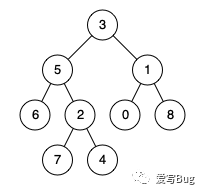题目:
给定一个二叉树, 找到该树中两个指定节点的最近公共祖先。
Given a binary tree, find the lowest common ancestor (LCA) of two given nodes in the tree.
百度百科中最近公共祖先的定义为:“对于有根树 T 的两个结点 p、q,最近公共祖先表示为一个结点 x,满足 x 是 p、q 的祖先且 x 的深度尽可能大(一个节点也可以是它自己的祖先)。”
According to the definition of LCA on Wikipedia: “The lowest common ancestor is defined between two nodes p and q as the lowest node in T that has both p and q as descendants (where we allow a node to be a descendant of itself).”
例如,给定如下二叉树: root = [3,5,1,6,2,0,8,null,null,7,4]
Given the following binary tree: root = [3,5,1,6,2,0,8,null,null,7,4]

示例 1:
输入: root = [3,5,1,6,2,0,8,null,null,7,4], p = 5, q = 1
输出: 3
解释: 节点 5 和节点 1 的最近公共祖先是节点 3。示例 2:
输入: root = [3,5,1,6,2,0,8,null,null,7,4], p = 5, q = 4
输出: 5
解释: 节点 5 和节点 4 的最近公共祖先是节点 5。因为根据定义最近公共祖先节点可以为节点本身。说明:
所有节点的值都是唯一的。
p、q 为不同节点且均存在于给定的二叉树中。
Note:
All of the nodes' values will be unique.
p and q are different and both values will exist in the binary tree.
解题思路:
只要熟悉树的遍历,应该都可以迅速完成该题。
关键点:
如果在 node 的左子树没找到与 p,q 相等的结点,递归函数返回null,公共祖先在右侧结点
如果在 node 的右子树没找到与 p,q 相等的结点,递归函数返回null,公共祖先在左侧结点
如果在 node 左右子树都找到与 p,q 相等的结点,递归函数返回公众祖先 node 结点
下面展示广度优先搜索的递归解法。
Java:
class Solution {
public TreeNode lowestCommonAncestor(TreeNode root, TreeNode p, TreeNode q) {
// 基线条件
if (root == null || root == p || root == q)
return root;
// 最小公共结点在左子树或右子树的情况
TreeNode leftNode = lowestCommonAncestor(root.left, p, q);
TreeNode rightNode = lowestCommonAncestor(root.right, p, q);
// 左子树或右子树未找到与 p,q 相等的结点时最小公共祖先在另一侧
if (leftNode == null)
return rightNode;
if (rightNode == null)
return leftNode;
return root;
}
}Python:
class Solution:
def lowestCommonAncestor(self, root: 'TreeNode', p: 'TreeNode', q: 'TreeNode') -> 'TreeNode':
if not root or root.val == p.val or root.val == q.val:
return root
left_node = self.lowestCommonAncestor(root.left, p, q)
right_node = self.lowestCommonAncestor(root.right, p, q)
if not left_node:
return right_node
if not right_node:
return left_node
return rootGolang:
func lowestCommonAncestor(root, p, q *TreeNode) *TreeNode {
if root == nil || root.Val == p.Val || root.Val == q.Val {
return root
}
leftNode := lowestCommonAncestor(root.Left, p, q)
rightNode := lowestCommonAncestor(root.Right, p, q)
if leftNode == nil {
return rightNode
}
if rightNode == nil {
return leftNode
}
return root
}





















 272
272











 被折叠的 条评论
为什么被折叠?
被折叠的 条评论
为什么被折叠?








